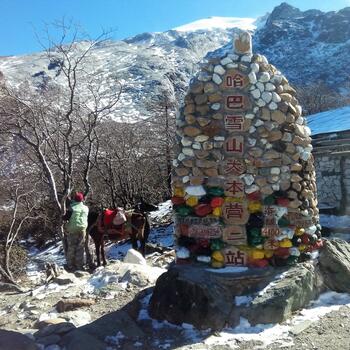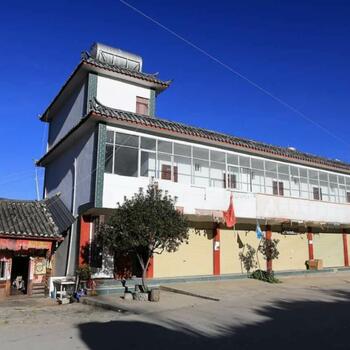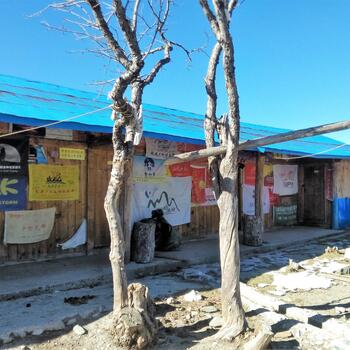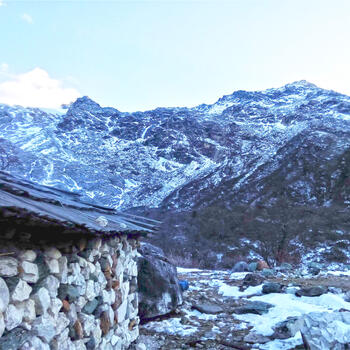Quick Menu
Getting to know Haba Snow Mountain
Haba Snow Mountain (哈巴雪山) is located in southeast Shangri-la County (香格里拉县) in Yunnan. It rises to 5,396 meters above sea level, making it one of the tallest peaks in the province. It is covered with snow year-round, but is relatively easy to ascend, making Haba a popular destination for both amateur and professional climbers.
This is an amazing trek not only for hiking enthusiasts, but also for those who just simply love nature and mountains. You have to be in a good physical shape though. If you are used to easy relaxing walks, this certainly won't be it. As Haba Snow Mountain is not technically difficult to climb, it is considered a perfect mountain for beginners who plan to someday climb the world's more challenging peaks.
I climbed it without any mountaineering experience, and for the first time in my life used crampons and an ice axe. If you also plan to climb Haba Snow Mountain with little or no previous experience, it is doable, but be sure to hire a local guide, just as I did. It will save you time and make the trip far safer.

Haba orientation and lodging
During our trip, we first visited Tiger Leaping Gorge (虎跳峡) for a two-day hike. Then, instead of going back to the city of Lijiang (丽江), we got on a minivan at the Middle Tiger Leaping Gorge, and headed towards Haba Village (哈巴村). It was quite an unprepared trip. We didn't even know where we would stay, or if climbing was possible in December.
There are a couple of guesthouses in Haba Village. Our driver dropped us at Haba Snow Mountain International Youth Hostel (哈巴雪山客栈). Without an advanced booking, we still managed to get a room. Because it was a late afternoon already, we decided to stay there as it seemed like the hostel was empty and there were plenty of free rooms, most likely due to it being low season. Being the middle of winter it was quite cold, but the hotel had electric blankets. We stayed in our beds all evening. The lady who owns the hostel was very friendly and helpful and cooked a delicious meal for her guests.

Necessary supplies, hiring a guide and renting horses
The base camp hut is a good shelter from the omnipresent wind and cold. There were even blankets inside. However, a sleeping bag is pretty much required. If you don't have your own climbing equipment, you can rent it in Haba Village. I didn't have crampons, an ice axe, or proper snow outerwear.
But we asked the hostel owner and she prepared everything necessary. You have to have proper waterproof shoes and clothes, warm gloves, a thick hat, a couple pairs of socks, sunscreen and lip balm. Also, take a mobile power bank and hiking stick. A headlamp is a necessity as well, as the climb to the mountaintop from base camp starts very early in the morning. I had a simple hand lamp, but it was very inconvenient to hold it in my hands while climbing up the mountain. My advice is to bring a quality headlamp and extra batteries, or rent them.
If you are not an experienced climber, you should certainly hire a mountain guide. He will bring you safely up and down the mountain and you should definitely listen to him if he says that the weather is not suitable enough to climb. We rented two horses, and the woman from the hostel was very insistent that our bags be carried by the horses. She was very worried that the walk would be too tiring otherwise. And while it was not the easiest hike, it was not actually that bad either. In the end, we could have carried our baggage ourselves, but still the horses were a help. So hiring ponies is not a must — and only totally necessary if you are worried about conserving energy for the push to the summit.

Setting out for base camp
We talked to the owner of our hostel about ascending the mountain, and she recommended starting our trip early the next morning. We had dinner and went to bed early. Next morning she woke us up, calling for us to come and eat. She had arranged our climbing guide, who was ready with horses and all the necessary equipment. We started our hike up the mountain soon after breakfast and it took about five or six hours from Haba Village to reach base camp 4,100 meters above sea level.
On the way, we stopped a couple of times to take photos and let our guide smoke a cigarette. In the middle of the hike, there was a wooden hut where we met a group of Chinese hikers. We rested there while having lunch and at the same time warmed ourselves next to a fire. Our horses had to rest as well. We spent about an hour there and reached base camp later in the afternoon. Even though we could have gone around and explored our surroundings, we decided instead to rest up to prepare for the climb the next day.

Climbing Haba Snow Mountain
We woke up very early — it was before 3am — and had a breakfast prepared by our guide. My guide and I were the first to leave. The Chinese group that we met the previous day started its ascent about one hour later. Luckily for me, we started early, because later on the wind got so strong that the group following us had to go back to base camp without reaching the mountaintop. They must have been quite disappointed.
At the beginning of the climb it was completely dark outside, and the headlamp was a necessity. The climbing stick made the entire journey far easier as well, especially when the climb gets very steep and the wind begins to blow. The higher you get, the more often you want to stop and have a rest, but the goal pushes you on.

We reached the top before 9am, and probably stood there for ten or 15 minutes. We couldn't stay any longer due to extremely strong winds and bitter cold. I took some photos with my phone, and then it switched off. Phone batteries drain incredibly fast at that elevation...or maybe my phone just froze.
Luckily, I had an actual camera too. But the wind became so strong that it was quite exhausting just standing up there. We couldn't stay much longer as our trip was only half finished. Getting down was probably even a bit harder than climbing up because of that wind. We had to stop very often and stand there with ice axes ready simply to not to be blown away. Finally, after a couple of hours struggling with the wind, we were back to base camp. It took around eight hours to climb up to the top and then return. The same afternoon, we left the main slopes of Haba Snow Mountain and hiked back to Haba Village.
Returning to civilization
We stayed one more night at the hostel in Haba Village, and the next morning planned to take a bus to Lijiang. Note that the village does not have a bus stop or specific bus schedule. Hostel owners have a pretty good idea of when the next buses are heading through town though, and in the morning ours woke us up in time for a quick breakfast before the bus to Lijiang arrived.
We hadn't really made any specific plans for this type of trip when we arrived in Yunnan. It was all quite spontaneous but turned out to be perfect. The local people we met were very friendly and will seemingly help with anything. But please keep in mind, you must be prepared to have your plans canceled by weather conditions.

I was extremely lucky because it was a sunny series of days with no clouds, and because we started early enough to make it to the top with the help of a seasoned guide. As mentioned before, the other hikers had to turn back because of strong winds. We also met two foreigners who were making a try of the ascent for the second time, also having been turned back by sudden inclement weather.
Pack properly, get acclimated to the elevation before you set out and remember that overnight temperatures can drop to -30 degrees centigrade without much notice during the winter months. The best time to climb Haba Snow Mountain is mid-March through June or mid-September until December. At other times the weather is too rainy, windy or snowy to make the attempt.

Travel expenses
Overall, I spent approximately 1,500 yuan for this trip. That includes bus tickets from Middle Tiger Leaping Gorge to Haba Village and then back to Lijiang, hiring a guide, renting equipment and two horses, our hostel stay, sleeping at the base camp hut and food. If you start your trip from Lijiang Bus Station (丽江客运站), a ticket to Haba Village costs around 40 yuan. When taking that route, you also have to pay a 65 yuan entrance fee for Tiger Leaping Gorge, whether you stop there or not. You should definitely stop though — the experience is well worth it.
Additional costs include a 200 yuan conservation fee to enter the Haba Snow Mountain area. Our guesthouse ran about 50 yuan per day per person, but that may rise to about 150 yuan during peak months. The guide also charged 100 yuan per day plus 150 for each horse. Gear rentals cost around 200 yuan. Overall, it is a small price to pay a great experience and an unforgettable adventure.
Editor's note: A version of this article by author Helena Vikmane was originally published on her website In Love With My Planet. All images belong to Vikmane unless otherwise noted in the caption. We thank her for allowing us to republish it here on GoKunming.
© Copyright 2005-2025 GoKunming.com all rights reserved. This material may not be republished, rewritten or redistributed without permission.

























评论
Climbed Haba a couple of years ago - just as the author says, it's a great climb requiring decent fitness but no need for ropes or technical climbing. Would be a good idea to know how to self-arrest if you fall and slide during the descent though, especially if you haven't used an ice-axe and crampons before. Also, be aware of the effects of altitude sickness; a bit of elevation acclimation beforehand would help cut the risk. Highly recommend this trip.
Sounds like a great trip, and some very sound advice. For anyone who has not climbed or hiked at altitude before, you need to be fit to cope with heights over 4500m, and the air seems to thin exponentially above that.
Andrew's advice is indeed good. Strongly suggest anyone doing this learn to self-arrest with an ice axe first - I (still) have a friend who literally saved his life by using one correctly to stop a fall on similar slopes that would certainly have killed him.
2-3 days' acclimatization at around 4000 meters is a good idea. - people can and do die by arriving in Lhasa, which is lower than 4000 meters, without acclimatizing (hey, most don't, but what seems like 'just a headache' can get real serious and you won't like it.
Amazing post! Very good work.
Could you give the contact of the local guide?
Or tell me where I can hire one of them?
Thanks!
You can hire a guide through any of the many guest houses in Haba Village. The author of the article stayed at Haba Snow Mountain International Youth Hostel, which is also known as Haba Snow Mountain Inn. You can find contact info at the Haba article at www.WikiVoyage.org. The "lady who owns the hostel" is Yang Xiu Lan (杨修兰). She is very helpful and gracious, even speaks a little English, with emphasis on little. Additional info on climbing the mountain can be found at www.ItinerantClimbersCollective.com, especially useful for those who who want to make the ascent on their own without guides (this assumes they already have experience with ice axe and glacier travel). The author climbed the mountain in December which is definitely off-season, and the prices mentioned are on the low side. During the standard climbing season costs are higher.
Yang Xiu Lan (杨秀兰)
Second character now correct.
Yang Xiu Lan's place is indeed the place to stay in Haba. Very helpfull and good cooking.
Haba is definately on the list. need to work out more for that lol...
Would anyone have some workout advice before hiking? I live in Kunming, if you jogged enough here would it be enough to get you somewhat prepared?
Yes. Spend time at higher altitude also.
Thanks and can you rent boots in Haba Village or do you have to bring your own?
I would never walk anywhere far in the mountains in anybody's boots but my own, well broken in buy my own feet.
That's by, no pun intended - you can't buy new feet.
Especially 7 days into a 2-week trek.
I have to agree with @alien. New or borrowed boots can lead to misery and pain. Take care of your feet.
登录评论